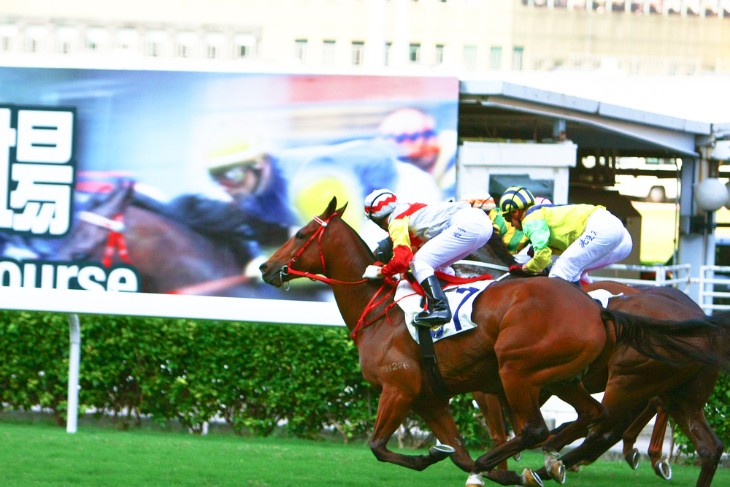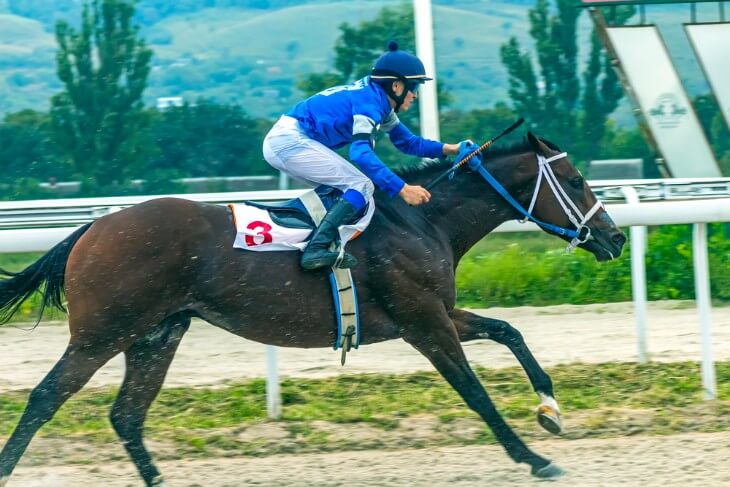[toc}
Many people think of horse racing as a tactical game involving gears for better performances and horses’ welfare. Racing fans do not pay attention to the tongue strap but it helps show how well racehorses are performing. This piece looks at why the tongue strap is important, its purpose, what it can accomplish as well as its application in horse-riding contests.
What is a Tongue Strap?
A tongue strap refers to an item used in horse racing. It can be made from cloth or other similar material, such as leather. The heart-shaped piece is fastened to the lower jaw by tying it to the horse's tongue.
It primarily helps horses breathe better. Occasionally, a horse may retract its tongue, blocking its airway and making it difficult to take in enough oxygen needed for maximum performance. This reduces speed in races. Holding the tongue steady during races ensures good breathability.
Tongue straps are simple but effective devices that do not require much training and can be fitted very quickly upon demand from trainers or handlers wishing their animals luck in performances. If you have such an equine, you would run faster and longer when your airways are not restricted.
Tongue straps are widely used among racing horses today, with most jockeys and trainers relying on them, especially those whose tongues tend to cause problems during competitions. Nevertheless, this does not mean that every horse needs these strips; however, they can make a huge difference if necessary.
A tongue strap keeps the tongue at its position, facilitating easier breathing for horses during races. This tool is user-friendly and highly assists horses in running within races.

The Purpose of a Tongue Strap
This tiny device allows better breathing while a horse is running at high speeds on tracks throughout various competitions. This is because when a horse is running, it needs to take in a lot of air. However, the horse sometimes pulls back its tongue and blocks its airway while running. Consequently, the result is disrupted breathing, which makes it less efficient. The strap holds the tongue, preventing it from going backwards and causing blockage of the throat, thus enabling a horse to breathe easily.
The tongue strap keeps the airways clear, ensuring that the horse can breathe more easily. When there is sufficient oxygen, horses are able to maintain speed and stamina throughout a race. A run with better breaths means improved performance for the animal.
Additionally, tongue straps have an essential safety function. If a horse is having trouble breathing, this might lead to poor performance, such as being upset or sick. In some cases, it can even lead to health problems. The function of this equipment is to ensure that horses' noses do not get blocked so that they can breathe without any issues and prevent dangers related to suffocation.
Trainers and jockeys often put tongue straps on horses whose breathing is affected by the shape of their tongues. Some horses are unsuitable for this equipment; others can benefit significantly. This gear is an uncomplicated yet productive device that allows a horse to reach its maximum potential.
Tongue straps help horses breathe better during racing. They do not allow the tongue to move out of place and block any possible obstruction, thus ensuring that a clear airway is maintained. In this regard, they help maximise performance and safety as well. Therefore, this tiny device performs some vital functions in assisting horses to get the most out of themselves on racetracks.
Benefits of Using a Tongue Strap
Using tongue straps in horse racing offers several advantages. Here are the major ones:
- Enhanced Breathing: A tongue strap enables a horse to breathe freely while racing. This tool simply keeps the mouth shut, allowing more air into the lungs and facilitating speed and stamina.
- Improved Performance: If properly used, it can be considered an added advantage for success at races since it facilitates the breathing process throughout the race by maintaining open airways. Consequently, such minor changes could make a massive difference in the overall performance of racehorses, enabling them to win races.
- Better Safety: It also makes horse racing safer because if there are no breathing problems, then there will be no respiratory distress during a race, for example, due to heat stressors leading to overheating, hyperventilation, excessive dust, etc., which may ultimately result in other health conditions jeopardising the horse's life.
- Reduced Stress Levels: Knowing that they can easily breathe well reduces anxiety, both on the part of these animals and also on the part of their riders, who would otherwise have been worried about uneven topping over cardiorespiratory systems-related issues with their mounts during competition or workout time when working them at faster paced than usual or taking part in galloping exercises together involving lots of friction created against the ground surface beneath.
- Simple and Effective: Tongue straps are practical and easy to use. For this reason, they do not require complicated arrangements or professional trainers. Trainers and handlers can quickly attach these items to the racecourse, making them convenient for many racing teams.
Tongue straps during horse races support improved breathing, performance enhancement, increased security, stress reduction, and simplicity. These benefits make them useful in horse racing, as they help horses exhibit their exceptional qualities while providing comfort and safety.
How to Apply a Tongue Strap
If you want to apply it correctly, ensure it will work well, and make a horse comfortable, you need to know the right way. It is not complicated but requires some action.
First, calm the horse down and make sure that it is relaxed. The process may be challenging if done on an anxious horse. Gently hold your horse's tongue so she does not withdraw it back. One should be soft when doing this so as not to stress or cause discomfort to the animal.
Then, wrap the tongue strap around the horse's tongue. Ensure that its position is accurate. It should be firm enough to hold the tongue in place without causing pain or impeding blood flow while lying flat against the tongue without twisting.
The next step involves securing it onto the lower jaw by tying the ends of these straps below the chin of a horse, usually. Make sure you tie your knot securely but not too tightly so that no harm will happen to your animal while its mouth stays fixed completely.
After fixing yours, check whether they are comfortable with them or not. Signs such as distressing could show that adjustments are needed to keep these items still during racing activities. Swallowing can also occur usually, even when horses wear devices that keep them from opening their mouths wide open.
The last thing we want here is any problems with our strapping coming off, so let us check once again by watching how everything goes before moving forward into more specific details like what kind of measures one must take where. At least one needs to monitor what happens with his/her mount during races along given lines shown towards the very end.
Applying a tongue strap means calming down horses, wrapping around their tongues, attaching them to lower jaws and ensuring comfort levels are maintained over time for monitoring purposes. All these will significantly enhance respiration rates among racing horses, thus boosting performance.

Common Concerns and Misconceptions
Many common concerns and misconceptions about using tongue straps in horse racing exist. These include:
- Horse Discomfort: Some people think a tongue strap may hurt or cause discomfort to the animal. However, if correctly applied, it is not supposed to be painful. It should be tight enough to hold the tongue in place but not so tight as to cause pain. The proper application ensures horse comfort throughout this procedure.
- Performance Affecting: The idea that using tongue straps can lower a horse's performance is erroneous. On the contrary, they make it easier for the pony's lungs so they will run better than ever before! They help open horses' airways so they do not lose their breath during races.
- Application Difficulty: Some individuals also believe that applying a tongue strap needs a delicate skill set. However, putting such devices on animals is relatively simple, though one would need some time practising with them as well as learning how trainers/handlers could put them right after getting some training process involved while others still maintain simplicity, allowing quick procedures; likewise, both implicated viewpoints hereof shall never lie apart from each other due their interdependence when considering the particular issue at hand through these respective perspectives too!
- Health Risks: People are afraid that those devices might somewhat threaten their health, though, if wrongly used, there is every probability of having problems with these items unlike any other. Although such risks are minimal, provided proper training has been carried out before application, all safety checks should be performed regularly to avoid anything wrong with the riding schools where you live.
- Necessity: Some wonder if tongue straps are necessary. Not all horses need tongue straps, though the use of tongue straps can be a game changer for those that do. This is especially beneficial to horses that have known problems with their tongues during racing.
However, these matters can be addressed through proper application and understanding despite concerns over discomfort, performance impairment, technicalities in wearing them, safety aspects, and need. A tongue strap can help in horse racing if adequately used.
Prevalence of Tongue Straps in Racing
Tongue straps are widely used in horse racing. Many trainers and jockeys employ this equine accessory to enhance their performance levels. They are important for such animals, as they often experience issues with tongues during any race. Choosing whether or not to use a tongue strap on a particular horse is typically based on the animal's previous form and needs.
While there are different types of races, tongue straps are used in flat and jump races. They do not restrict themselves to any specific genre of sports or races; it is only fit for purpose across different disciplines amongst trainers. It ensures easy breathing throughout the race, hence maintaining good performance by these trainers.
In competitive racing environments, every advantage counts. By enhancing its breathing capacity and, thus, stamina, as well as the speed of the horse, a tongue strap can add that extra edge to it. Consequently, this makes it an essential instrument that trainers aim to use to get the most out of their horses.
A significant number will wear no other bridle but one with a tongue strap warning sign given their habits like pulling back their tongues, thus interfering with respiration processes for air flow through nostrils, hence giving vital assistance which improves breathing so highly demanded by holding breaths. Our coaches carefully consider what devices will help maintain peak performance as they closely monitor our charges.
However, spectators might never spot them among horses on the race course since tongue straps are tiny and not easily noticeable to people who do not know where to look. Nonetheless, these items significantly impact horses' performance as part of many racing strategies.
Tongue straps are used in horse racing to improve breathing and performance. They are commonly used in flat and jump racing, which is an essential tool for horses that require them. This choice is made after careful examination of each animal's performance.
Bottom Line
A tongue strap in horse racing is designed to help horses breathe better during races and perform optimally. It keeps the airway open and enhances overall performance by keeping the tongue from blocking it. Although seemingly insignificant, a tongue strap can significantly affect a racehorse's performance. When carefully applied with regular checkups,, it becomes one of the most valuable assets in any racehorse kit.
For more information:







